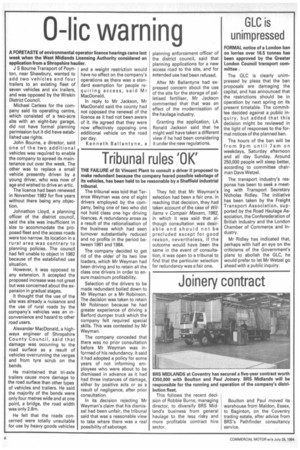Odic warning
Page 8

If you've noticed an error in this article please click here to report it so we can fix it.
A FORETASTE of environmental operator licence hearings came last week when the West Midlands Licensing Authority considered an application from a Shropshire haulier.
J S Bourne Transport of Poynton, near Shawbury, wanted to add two vehicles and four trailers to an existing fleet of seven vehicles and six trailers, and was opposed by the Wre kin District Council.
Michael Carless for the company said its operating centre, which consisted of a two-acre site with an eight-bay garage, did not have formal planning permission but it did have established use rights.
John Bourne, a director, said one of the two additional vehicles was required to enable the company to spread its maintenance out over the week. The other was to replace a small vehicle presently driven by a young driver, who was now of age and wished to drive an artic.
The licence had been renewed in November 1982 for five years without there being any objection.
Johnathon Lloyd, a planning officer of the district council, said the site was insufficient in size to accommodate the proposed fleet and the access roads were too narrow. Its location in a rural area was contrary to planning policies. The council had felt unable to object in 1982 because of the established use situation.
However, it was opposed to any extension. It accepted the proposed increase was not great but was concerned about the expansion in gradual stages.
It thought that the use of the site was already a nuisance and the use of rural roads by the company's vehicles was an inconvenience and hazard to other road users.
Alexander MacDonald, a highways engineer of Shropshire County Council, said that damage was occurring to the road surface as a result of vehicles overrunning the verges and from tyre scrub on the bends.
He maintained that tri-axle trailers cause more damage to the road surface than other types of vehicles and trailers. He said the majority of the bends were only four metres wide and at one point, a bridge, the road width was only 2.8m.
He felt that the roads concerned were totally unsuitable for use by heavy goods vehicles and a weight restriction would have no effect on the company's operations as there was a standard exemption for people requiring access, said Mr MacDonald.
In reply to Mr Jackson, Mr MacDonald said the county had not opposed the renewal of the licence as it had not been aware of it. He agreed that they were now effectively opposing one additional vehicle on the road per day.
Kenneth Ballantyne, a planning enforcement officer of the district council, said that planning applications for a new access road to the site, and for extended use had been refused.
After Mr Ballantyne had expressed concern about the use of the site for the storage of palletised fertiliser, Mr Jackson commented that that was an effect of the modernisation of the haulage industry.
Granting the application, LA Ronald Jackson said that he might well have taken a different view if he had been considering it under the new regulations.




























































































